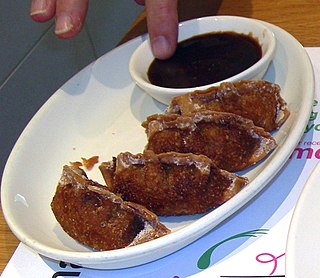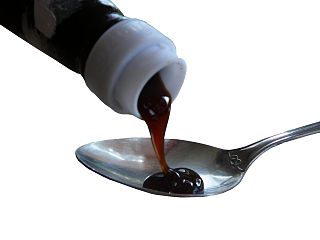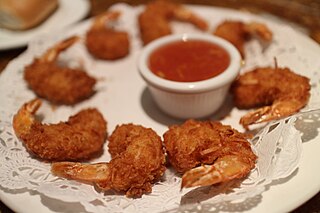
American Chinese cuisine is a style of Chinese cuisine developed by Americans of Chinese descent. The dishes served in many North American Chinese restaurants are adapted to American tastes and often differ significantly from those found in China.

Teochew cuisine, also known as Chiuchow cuisine, Chaozhou cuisine or Chaoshan cuisine, originated from the Chaoshan region in the eastern part of China's Guangdong Province, which includes the cities of Chaozhou, Shantou and Jieyang. Teochew cuisine bears more similarities to that of Fujian cuisine, particularly Southern Min cuisine, due to the similarity of Chaoshan's and Fujian's culture, language, and their geographic proximity to each other. However, Teochew cuisine is also influenced by Cantonese cuisine in its style and technique.

Fish sauce is a liquid condiment made from fish or krill that have been coated in salt and fermented for up to two years. It is used as a staple seasoning in East Asian cuisine and Southeast Asian cuisine, particularly Burma, Cambodia, China, Indonesia, Laos, Malaysia, Philippines, Taiwan, Thailand, and Vietnam.

In cooking, a sauce is a liquid, cream, or semi-solid food, served on or used in preparing other foods. Most sauces are not normally consumed by themselves; they add flavor, moisture, and visual appeal to a dish. Sauce is a French word taken from the Latin salsa, meaning salted. Possibly the oldest recorded European sauce is garum, the fish sauce used by the Ancient Greeks; while doubanjiang, the Chinese soy bean paste is mentioned in Rites of Zhou in the 3rd century BC.

Soy sauce is a liquid condiment of Chinese origin, made from a fermented paste of soybeans, roasted grain, brine, and Aspergillus oryzae or Aspergillus sojae molds. Soy sauce in its current form was created about 2,200 years ago during the Western Han dynasty of ancient China, and spread throughout East and Southeast Asia where it is used in cooking and as a condiment.

Sweet and sour is a generic term that encompasses many styles of sauce, cuisine and cooking methods. It is commonly used in China, has been used in England since the Middle Ages, and remains popular in Europe and in the Americas.

Zhajiangmian, or "noodles with soybean paste", is a Chinese dish consisting of thick wheat noodles topped with zhajiang sauce. Zhajiang sauce is normally made by simmering stir-fried ground pork or beef with salty fermented soybean paste. Zhajiang also means "fried sauce" in Chinese. Although the sauce itself is made by stir-frying, this homonym does not carry over into the Classical Chinese term.

Tianmian sauce, also known as Sweet bean sauce, sweet flour sauce or sweet wheat paste, is a thick, smooth, dark brown or black paste with either a mild, savory or sweet flavor. It is commonly used in Northern Chinese cuisine, Northeastern Chinese cuisine, as well as Korean-Chinese cuisine. Peking duck and jajangmyeon are two popular dishes that feature the sauce.

Egg foo young is an omelette dish found in Chinese Indonesian, British Chinese, and Chinese American cuisine. The name comes from the Cantonese language. Egg foo young is derived from fu yung egg slices, a mainland Chinese recipe from Guangdong.

Plum sauce is a viscous, light brown sweet and sour condiment. It is used in Chinese cuisine as a dip for deep-fried dishes, such as spring rolls, egg rolls, noodles, and deep-fried chicken balls as well as for roast duck. It is made from sweet plums or other fruit such as peach, pineapple or apricot, along with sugar, vinegar, salt, ginger and chili peppers.

Duck sauce is a condiment with a sweet and sour flavor and a translucent orange appearance similar to a thin jelly. Offered at Chinese-American restaurants, it is used as a dip for deep-fried dishes such as wonton strips, spring rolls, egg rolls, duck, chicken, fish, or with rice or noodles. It is often provided in single-serving packets along with soy sauce, mustard, hot sauce or red chili powder. It may be used as a glaze on foods, such as poultry. Despite its name the sauce is not prepared using duck meat.

Siomay, is an Indonesian steamed fish dumpling with vegetables served in peanut sauce. It is derived from Chinese Shumai. It is considered a light meal that is similar to the Chinese Dim Sum, but is cone shaped. It is traditionally made from tenggiri (wahoo) fish meat. Sometimes other types of seafood such as tuna, mackerel, and prawn also can be used to make siomay. Other complements to siomay are steamed cabbage, potatoes, bitter gourd, boiled egg, and tofu. Siomay is cut into bite size pieces and topped with peanut sauce, sweet soy sauce, chili sauce and a dash of lime juice.

Tauco, Taucu, Taotjo or Tauchu is a paste made from preserved fermented yellow soybeans in Chinese Indonesian and Malaysian cuisines. Tauco is made by boiling yellow soybeans, grinding them, mixing them with flour and fermenting them in order to make a soy paste. The soy paste is soaked in salt water and sun-dried for several weeks, furthering the fermentation process, until the color of the paste has turned yellow-reddish. Good tauco has a distinct aroma. The sauce is also commonly used in other Indonesian cuisines traditions, such as Sundanese cuisine and Javanese cuisine. Taucu is generally used in cooking by Chinese Malaysian, Singaporean and Bruneian.

Crab in oyster sauce or oyster sauce crab is a Chinese seafood dish of crab served in savoury oyster sauce. It is a popular dish in Asia, that can be found from China, Singapore, Indonesia to the Philippines.

Spring rolls are a large variety of filled, rolled appetizers or dim sum found in East Asian, South Asian, and Southeast Asian cuisine. The name is a literal translation of the Chinese chūn juǎn. The kind of wrapper, fillings, and cooking technique used, as well as the name, vary considerably within this large area, depending on the region's culture.

A wonton is a type of Chinese dumpling commonly found across regional styles of Chinese cuisine.

Hoisin sauce is a thick, fragrant sauce commonly used in Chinese cuisine as a glaze for meat, an addition to stir fries, or as dipping sauce. It is darkly colored in appearance and sweet and salty in taste. Although regional variants exist, hoisin sauce usually includes soy beans, fennel seeds, red chillies, and garlic. Vinegar, Chinese five spice and sugar are also commonly added.

Oyster sauce describes a number of sauces made by cooking oysters. The most common in modern use is a viscous dark brown condiment made from oyster extracts, sugar, salt and water thickened with corn starch. Some versions may be darkened with caramel, though high-quality oyster sauce is naturally dark. It is commonly used in Cantonese, Thai, Malay Cuisine, Vietnamese and Khmer cuisine.



















